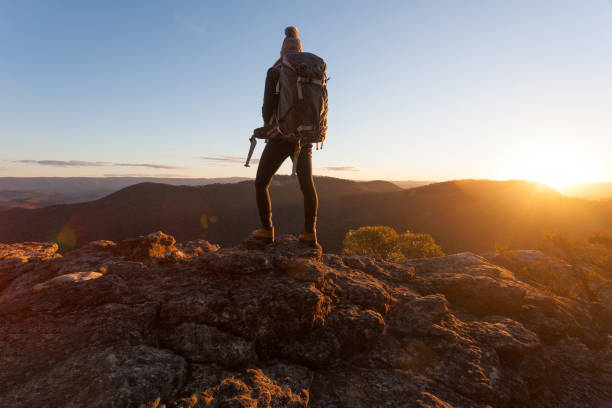
If you’re searching for the most breathtaking and invigorating hiking experiences, the Blue Mountains in Australia offer some of the world’s most stunning trails. Known for its dramatic scenery, eucalyptus forests, and rugged cliffs, the region boasts a variety of hikes that cater to all ages and fitness levels. Whether you’re a casual walker or an avid trekker, this guide will introduce you to the best hikes the Blue Mountains have to offer. From witnessing the majestic sunset on a Blue Mountains sunset tour to conquering challenging peaks, there’s a memorable adventure waiting for every hiker.
Understanding the Blue Mountains Terrain

The Blue Mountains are not only famous for their panoramic vistas but also for their rich biodiversity. Home to over 400 different kinds of animals and a myriad of plant species, the terrain ranges from deep valleys and sandstone plateaus to cascading waterfalls and dense forests. With the eucalyptus trees releasing fine mist into the air, it creates the distinctive blue-hazy horizon that is synonymous with the region and gives the mountains their name.
| Species Type | Examples |
|---|---|
| Mammals | Spotted-tailed Quoll, Greater Glider |
| Birds | Yellow-Tailed Black Cockatoo, Superb Lyrebird |
| Plants | Wollemi Pine, Blue Mountain Ash |
Weather Patterns and Best Times to Hike
The Blue Mountains can be visited year-round, but the preferred time for hiking is from April to November when the temperature is cooler, and the skies are clearer. During this period, you’re less likely to encounter the summer’s heat and heavy rainfall which can lead to dangerous conditions. Keep in mind that weather in the mountains can be unpredictable, so it’s always best to check the forecast before heading out and be prepared for sudden changes.
Preparing for Your Hiking Adventure
Packing the right equipment is crucial for a successful hike in the Blue Mountains. Essential items include comfortable hiking shoes, a well-fitted backpack, adequate water, snacks, a map or GPS device, and a first-aid kit. Given the variable climate, it is also wise to bring layered clothing and a waterproof jacket. For those planning to witness the sunset, a headlamp or flashlight is a must-have for a safe navigation back.
Your safety and the preservation of the Blue Mountains go hand in hand. Always stick to the marked paths to prevent erosion and harm to the local habitat. It’s crucial to carry out all your rubbish and leave no trace behind. In terms of safety, never hike alone, inform someone about your plans, and carry a fully charged mobile phone. Should you encounter any wildlife, observe quietly from a distance without attempting to feed or touch the animals.
The Top Blue Mountains Hikes
Easy Trails for Beginners and Families
The Three Sisters Walk – A Gentle Introduction
This short and sweet trail is perfect for those new to hiking or travelling with children. It offers stunning views of the iconic Three Sisters rock formation and is especially magical during sunset. The walk is well-paved and offers various lookouts for capturing that perfect photograph. It’s a leisurely trek that encapsulates the essence of the Blue Mountains’ panoramic beauty.
Wentworth Falls Track – A Scenic Family-Friendly Route
The Wentworth Falls Track is an idyllic hike for families looking to experience the majestic waterfalls and lush greenery of the Blue Mountains. It’s an intermediate walk that leads to breathtaking views of the falls and the Jamison Valley. Picnic areas along the route make it an enjoyable day out for everyone.
Intermediate Trails for Seasoned Hikers
Grand Canyon Track – Exploring the Depths of the Blue Mountains
The Grand Canyon Track is an immersive experience for those desiring a more advanced hike. This loop takes you into the heart of the Blue Mountains, through a labyrinth of sandstone walls, native rainforest, and trickling streams. The well-marked trail requires some level of fitness, especially as it involves several steep climbs and descents.
Katoomba’s Cliff Top Walking Track – Spectacular Views
This track offers some of the most dramatic lookout points in the Blue Mountains. Stretching from Katoomba to Echo Point, hikers are treated to the vast expanse of the mountains and valleys. It’s an intermediate-level walking track with some uneven terrains but immensely rewarding with its stunning views.
Challenging Tracks for the Adventure Seekers
The Six Foot Track – A Three-Day Hiking Challenge
For the daring hiker, the Six Foot Track presents a three-day expedition from Katoomba to Jenolan Caves. The 45 km route traverses diverse landscapes including open forests, heathland, and alpine swamps. While the track is clearly signposted, it’s best suited to experienced hikers due to its length and challenging terrain.
Mount Solitary – A Trek for Experienced Hikers
Mount Solitary is one of the Blue Mountains’ most formidable treks. This rigorous day walk offers adventurers solitude, challenge, and the reward of unparalleled views at the summit. With steep ascents and rocky outcrops, it’s a journey designed for the well-prepared and seasoned hiker.
Beyond the Hike – Other Attractions in the Blue Mountains
Cultural Experiences and Local Towns
After exploring the trails, take the time to dive into the cultural aspects of the Blue Mountains. Indigenous walking tours offer insightful narratives about the land’s original custodians. Meanwhile, the local towns of Leura, Katoomba, and Blackheath have charming galleries, bookshops, and cafes worth visiting.
Relaxation After the Trails
Following a day of hiking, there’s nothing like unwinding in one of the Blue Mountains’ serene settings. From luxury spa retreats to cozy mountain lodges, there are ample opportunities for relaxation, rejuvenation, and reflection on the day’s achievements.
Conclusion
The Blue Mountains are a hiker’s paradise with trails to suit every preference and skill level. Whether it’s embarking on a family-friendly walk, a Blue Mountains sunset tour, or tackling a more strenuous expedition, the natural beauty and expansive vistas are bound to leave a lasting impression. Remember to prepare adequately, hike responsibly, and fully immerse yourself in the splendor of the Blue Mountains.
FAQ Section
- What is the best time of year to hike in the Blue Mountains?
- Do I need a permit to hike in the Blue Mountains?
- Are there guided tours available for Blue Mountains hikes?
- How can I ensure I’m respecting the ecological integrity of the Blue Mountains while hiking?
- What emergency procedures should I be familiar with when hiking in the Blue Mountains?
The best time to hike in the Blue Mountains is from April to November when the weather is cooler and more stable, making for pleasant hiking conditions.
For most hikes, no permits are required. However, for specific multi-day hikes such as the Six Foot Track, you may need to book campsites or obtain a pass.
Yes, guided tours are available and cater to different levels of experience, offering both safety and valuable insights into the region’s landscape and history.
Stay on marked trails, pack out all trash, avoid disturbing wildlife, and comply with fire regulations. Practices such as these help preserve the area for future generations.
Always let someone know your itinerary, carry adequate safety gear, and have a plan for signaling for help. In emergencies, call the local emergency services.

